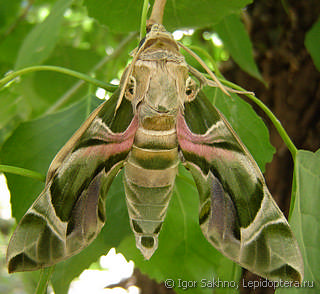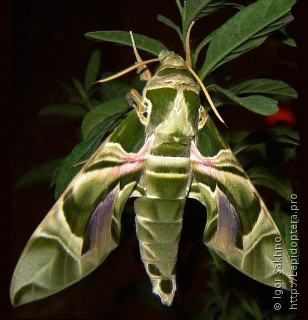Daphnis nerii (Linnaeus, 1758)

Taxonomy
class Insecta → subclass Pterygota → infraclass Neoptera → superorder Holometabola → order Lepidoptera → superfamily Bombycoidea → family Sphingidae → subfamily Macroglossinae → tribe Macroglossini → subtribe Macroglossina → genus Daphnis → species Daphnis nerii
Species name(s)
Daphnis nerii (Linnaeus, 1758) = Sphinx nerii Linnaeus, 1758 = infernelutea Saalmüller, 1884 = confluens (Closs, 1912) = nigra Schmidt, 1914 = Deilephila nerii bipartita Gehlen, 1934. [9, 10]
Oleander Hawk-moth.
urn:lsid:insecta.pro:taxonomy:2838
Expansion
This species marks on the maps: 1.
Zoogeographical regions
Palaearctic, Ethiopic, Indo-Malayan.
Russia regions
#13. Zapadno-Kavkazsky.
Forewing length
45—65 mm.
Wingspan
95—100 mm.
Primary colors
Red, Green, Brown/Gray/Black.
Flight time
| January | February | March | April | May | June | July | August | September | October | November | December |
Larva lifespan
| January | February | March | April | May | June | July | August | September | October | November | December |

Detailed information with references
Distribution
- Albania, Austria, Belgium, Bulgaria, Great Britain, Hungary, Germany, Greece, Denmark, Ireland, Spain, Italy, Corsica, Crete, Latvia, Luxembourg, Malta, Netherlands, Norway, Poland, Portugal, Romania, Sardinia, Sicily, Slovakia, Turkey - European part, Finland, France, Czech Republic, Switzerland, Sweden, Estonia, Yugoslavia. [1].
- Austria, Azores?Albania, Belarus, Belgium, Bulgaria, Bosnia and Herzegovina, the British Isles, France, Germany, Greece (mainland), Denmark (mainland), Ireland, Spain (mainland), Italy (mainland), Cyprus, Corsica, Crete, Latvia, Lithuania, Luxembourg, Macedonia, Malta, Netherlands, Norway (mainland)Channel Islands, Poland, Portugal (mainland), Romania, Russia, Sardinia, Northern Ireland, Sicily, Slovakia, Slovenia, Turkey (European part), Ukraine, Finland, France (mainland), Croatia, Czech Republic, Switzerland, Sweden, Estonia, Yugoslavia. [10].
- Regions of the Russian Federation: the Western Caucasus. [3].
- Areal - Southern Europe. Africa, the Middle East to India. Occasionally - Central Europe. [5].
- It is distributed throughout Africa, India, and the Mediterranean countries. It is found in the Crimea, Moldova, the North Caucasus and Transcaucasia. [259].
Imago Habitus and Differences from alike species
- Length of front wing - 4.5, and even 6.5 cm, the wings themselves are narrow, with a wavy bottom edge. Strongly wavy. All wings of marsh-green, with lighter fields and pinkish spots, which is a butterfly is sitting on an oleander bush. The body of the butterfly stocky, head and back of green, and the rear wings much smaller, when compared with the front. [5].
- Wingspan from 95 to 100 mm [259].
General info about Imago
- In the Mediterranean - the valley of the rivers and streams dried up riverbed (there is usually grow oleander bushes). In Central Europe, where the flies though - if only to find that oleander. Imago oleander hawk moths are active at night. [5].
Imago lifespan
- The first butterflies appear north of the Alps in June, and their descendants continue to fly until September. [5].
- It flies from April to September. Gives 2-3 generations. [259].
General info about Larva
- Caterpillar large, colorful, green and pink, with a white line on the sides and a horn at the end of the abdomen, so even with the raised spots. Pupation occurs in loose soil. [5].
Larva food plants / other food objects
- Oleander (Nerium oleander), sometimes periwinkle. [5].
- Oleander. [259].
Larva lifespan
- Daphnis nerii larvae live from July to September. [5].
- From spring to autumn. [259].
Pupa
- It overwinters in the soil. [259].
Overwintering stage
Authors
Initial species uploading to the site: Peter Khramov.
Photos:
Igor Sakhno. Text data: Peter Khramov.
The species characteristics formalization: Peter Khramov.
References
- [1] O. Karsholt, J. Razowski (eds.), 1996. The Lepidoptera of Europe: a distributional checklist
- [3] Каталог чешуекрылых (Lepidoptera) России. Под ред. С. Ю. Синёва. СПб.; М.: Товарищество научных изданий КМК, 2008
- [5] Райххолф-Рим Х. Бабочки. М.: Астрель, 2002
- [9] Tree of Life (funet.fi), 2012
- [10] de Jong, Y.S.D.M. (ed.) (2011) Fauna Europaea version 2.4 (faunaeur.org)
- [259] Бабочки Закавказья. М.: Планета, 1988
Comments
Note: you should have a Insecta.pro account to upload new topics and comments. Please, create an account or log in to add comments
Daphnis nerii photos
Other species Daphnis

















































